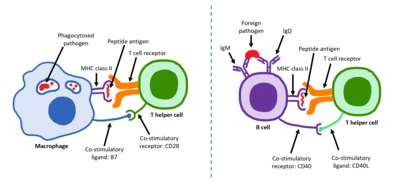T helper cell
The T helper cells (Th cells), also known as CD4+ cells or CD4-positive cells, are a type of T cell that play an important role in the immune system, particularly in the adaptive immune system. As their name suggests, they "help" the activity of other immune cells by releasing cytokines, small protein mediators that alter the behavior of target cells that express receptors for those cytokines. These cells help to polarize the immune response into the appropriate kind depending on the nature of the immunological insult (virus vs. extracellular bacterium vs. intracellular bacterium vs. helminth vs. fungus vs. protist). They are generally considered essential in B cell antibody class switching, breaking cross-tolerance in dendritic cells, in the activation and growth of cytotoxic T cells, and in maximizing bactericidal activity of phagocytes such as macrophages and neutrophils.
Mature Th cells express the surface protein CD4 and are referred to as CD4+ T cells. Such CD4+ T cells are generally treated as having a pre-defined role as helper T cells within the immune system. For example, when an antigen-presenting cell displays a peptide antigen on MHC class II proteins, a CD4+ cell will aid those cells through a combination of cell to cell interactions (e.g. CD40 (protein) and CD40L) and through cytokines.
CD154, also called CD40 ligand or CD40L, is a cell surface protein that mediates T cell helper function in a contact-dependent process[1] and is a member of the TNF superfamily of molecules. It binds to CD40 on antigen-presenting cells (APC), which leads to many effects depending on the target cell type. CD154 acts as a costimulatory molecule and is particularly important on a subset of T cells called T follicular helper cells (TFH cells).[2] On TFH cells, CD154 promotes B cell maturation and function by engaging CD40 on the B cell surface and therefore facilitating cell-cell communication.[3] A defect in this gene results in an inability to undergo immunoglobulin class switching and is associated with hyper IgM syndrome.[4] Absence of CD154 also stops the formation of germinal centers and therefore prohibits antibody affinity maturation, an important process in the adaptive immune system that allows for the generation of high-affinity antibodies that protect against future challenge by pathogens.
The importance of helper T cells collectively can be seen from HIV, a virus that primarily infects CD4+ T cells (but is capable of infecting other important cells of the immune system, like macrophages that express CD4). In the advanced stages of HIV infection, loss of functional CD4+ T cells leads to the symptomatic stage of infection known as the acquired immunodeficiency syndrome (AIDS). When HIV is detected early in blood or other bodily fluids, proper adherence to antiretroviral therapy will prevent the progression of HIV into AIDS and allow the body to naturally restore its own CD4 cell count (a small proportion of individuals is able to achieve prolonged control of viral load without significant decline in T cell levels over time without the aid of antiretroviral therapy, who are termed "elite controllers" or "long-term nonprogressors"). HIV is an example of a secondary immunodeficiency disorder. Primary immunodeficiencies are genetic conditions which result in immunological defects that prevent adequate clearance of infections and T cell deficiencies are particularly devastating. One example is SCID (severe combined immunodeficiency) which has many causes and varies in its precise phenotype depending on the cause. While most forms of SCID result in absence of both T and B cell lineages, atypical SCID is characterized (in part) by a normal level of B cells but profound T cell deficiency. However, because of the deficiency of helper T cells, the B cells have profoundly impaired function.[5]
